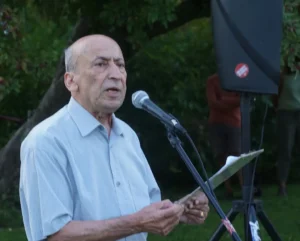Peace Portraits: Pathways to Nonkilling
REVIEWS, 9 Oct 2023
Review by Robin Collins of a Memoir by Balwant Bhaneja – TRANSCEND Media Service
“Everyone has the right not to be killed and the responsibility not to kill others.”
Peace Portraits: Pathways to Nonkilling–A Memoir by Balwant Bhaneja
“Everyone has the right not to be killed, and responsibility not to kill others” is the mission but this book is very much a personal journey for Balwant (Bill) Bhaneja, retired science diplomat from the Canadian foreign service, in his quest for spiritual fulfillment through the practice of non-killing peaceful methods.
Bhaneja outlines the influence of five peace leaders on his own life and in their advocacy for the greater good. The term Nonkilling peace is the “highest measure of human progress”, whereas the term “peace” has been misused as justification for insurgency, war, and colonial or religious expansion. Nonkilling is therefore the purer subset of peace, and in the view of Bhaneja and other advocates of non-violence, the best available option.
For two of those portrayed in this short 94-page memoir, Mahatma Gandhi and Sri Sathya Sai, Bhaneja admits to only brief up-close glimpses of them. Gandhi, when the author was a six year old, accompanying his father to Birla House in New Delhi in 1947 for an outdoor prayer meeting, two months after Indian Independence:
”Gandhi emerged from the big house, walking in the direction of the dais — a frail old man in white loincloth, his bare chest covered by a cotton white shawl, his arms rested on the shoulders of two young women also in white Indian dress. There was a hush around.”
Three months later, Gandhi would be assassinated by a Hindu fanatic.
Gandhi had been a truth-seeker and advocate for a united India and is said to have proclaimed that “You’ll have to divide my body before you divide India.” His hopes were dashed, of course, despite being “singly responsible for mobilizing the Indian masses, bringing into them a sense of unity of purpose” to achieve independence from Britain through nonviolence (through “Ahimsa”, a mark of one’s inner strength and courage).
Most memorable among Bhaneja’s recollections are his recall of walking the streets of London after the death of (Princess) Diana Spencer, the evening before her funeral, inspecting the piles of flowers and notes left by her admirers; as well as his failed effort to arrange an “interview” with Sri Sathya Sai in the aftermath of his own tortured loss of family members.
Mystical and supernatural claims aside, Sathya Sai was an Indian Hindu reform guru known for establishing safe drinking water facilities for the rural poor and for philanthropic hospital projects. Bhaneja recalls the day of the hoped-for meeting:
“I recognized the morning classical raga being played on Sitar. There were whispers that the music meant Swami had left his abode to walk through the audience. There was anticipation in the air. I could see in the distance the holy man Sai Baba in his ochre coloured robe with a crown of afro-hair gently moving with grace to the slow pace of the music, his long robe hid his bare feet.”
Sathya Sai, who showed little interest in travel outside of India despite requests by his followers, spent much of his time advocating helping others, “not to convert anyone,” Bhaneja writes, “but hoping for your own transformation through inner joy of doing selfless service — serving for service sake.”
Non-violence and non-killing
Nobel Peace Prize Winner Mairead Maguire (co-awarded with Betty Williams in 1997) came to a position of non-violence when she found herself challenging ‘Just War’ theory (“a phony piece of morality” she called it). It remains a framework that distinguishes legitimate from illegitimate use of force in conflict, and undergirds some of our international law doctrine. In her view a nonkilling future is possible, but it is a choice, “both a spiritual and a political choice and it is a personal and a community one, as we commit ourselves to the nonviolent service of others.” This would apply, she stated, even if the nonkilling worldview is not achieved in our lifetimes. At her invitation, Bhaneja visited Northern Ireland to learn more about the Peace Process, the dispossession of guns and ammunition program and the restorative justice and reconciliation effort (a practice of consensus decision-making — listening and unconditional dialogue.)
Most striking about the peace achieved in the region (however wobbly it may be today), was its being established through the courageous political leadership of a handful of individuals who took tremendous personal and political risks.
Maguire’s inspiration, as with several of the advocates in Bhaneja’s book, was the spiritual dimension (or overtly religious point of view) and this may not sit comfortably with the more secular reader looking for only evidence-based morsels. Here, Glenn Paige would seem to agree (as does Bhaneja and others who are portrayed, including Maguire herself, to some extent.) Whether the Golden Rule or the principle of reciprocity, it didn’t matter the source; they were the same concept.
The chapter about former Canadian Prime Minister Lester Pearson’s contributions includes his development of the idea of a United Nations Emergency Force, as was deployed in the Egypt-Britain-France Suez canal crisis in 1956 (before he was Prime Minister) and for which he won a Nobel Peace Prize. But it was while a student at Carleton University in 1970 that Bhaneja knew Pearson as his professor, and as a staunch advocate of the principle that rich countries, such as Canada, should increase their aid budgets to help alleviate poverty in the developing world. Bill later came to know Pearson’s son, Geoffrey, who confided that his father was “not an abstract thinker, not a ‘peacenik’…” but someone “with a sense of history” in a conflicted world “caught up in the nuclear chill of cold war.” Geoffrey Pearson told him: “The mark of a great leader is to seize the day, to make use of opportunities at hand.” Pragmatist over idealist.
Glenn Paige’s life’s work was similarly in support of solid, practical, empirically-determined claims, which he gathered together in his magnum opus, “Nonkilling Global Political Science”’ (2002). He was a firm advocate of Gandhi’s work, we are informed, but he sought to connect evidence-based social science to those shared maxims, such as “Thou shalt not kill”, that appear across the spectrum of different faiths. He hoped to provide an academic foundation to nonkilling rather than viewing it as primarily a personal spiritual quest. On the economic front, Paige would question whether “any economic system can sustain itself without killing?”
With 7,000 cultures on earth, conflicts are unsurprisingly often “happening as proxy wars at cultural-ethnic levels.” They require “imaginative approaches to create interventions” that address “historical, cultural and religious minutiae” through reconciliation and mediation. Paige’s work focussed on the root cause of killings and therefore “the unmet needs” of those affected that can lead to “prolonged stalemates” (the Ukraine-Russia conflict comes to mind, obviously.) Bhaneja came to be closely associated with Paige, having served as Vice Chair from 2008-16 when Paige stood as Chair of the Centre for Global Nonkilling.
What the five portraits share, Bhaneja believes, is “a global vision of unity of faiths, a notion of common humanity, and a belief in prevention of wars and violence.” This is the theme,, but the author’s own intimately described experiences are what drive the narrative of this book (not unlike with an earlier book by Bhaneja, “Troubled Pilgrimage” when he reflected on an event in a train car where he is forced to challenge his own prejudices.) As with insider-baseball, you may not grasp some of the detail in the Hindu references or the spiritual quest the author describes, but you will still appreciate the enthusiasm of the game’s adherent, and the complexity of Bhaneja’s commitment to nonkilling peace.
______________________________________________________
This is the original version of a review published in the Oct-Dec 2023 edition of Peace Magazine.
 Dr. Bill (Balwant) Bhaneja is a former Canadian science diplomat, a member of the TRANSCEND Network for Peace Development Environment, and author of six books and scholarly papers on politics and science. He holds a PhD in science policy from UK’s Victoria University of Manchester, currently serves as Senior Advisor to the Center for Global Nonkilling in Honolulu-Hawai’i of which he is a founding member, and produces the Nonkilling Arts Research Committee (NKARC) Newsletter. A peace activist, his recent books include: Troubled Pilgrimage: Passage to Pakistan (TSAR/Mawenzi, Toronto, 2013); Quest for Gandhi: A Nonkilling Journey (Center for Global Nonkilling, Hawaii, 2009); and in collaboration with Vijay Tendulkar, Two Plays: The Cyclist and His Fifth Woman (Oxford University Press (India), New-Delhi, 2006). He lives in Ottawa, Canada. Email: billbhaneja@rogers.com
Dr. Bill (Balwant) Bhaneja is a former Canadian science diplomat, a member of the TRANSCEND Network for Peace Development Environment, and author of six books and scholarly papers on politics and science. He holds a PhD in science policy from UK’s Victoria University of Manchester, currently serves as Senior Advisor to the Center for Global Nonkilling in Honolulu-Hawai’i of which he is a founding member, and produces the Nonkilling Arts Research Committee (NKARC) Newsletter. A peace activist, his recent books include: Troubled Pilgrimage: Passage to Pakistan (TSAR/Mawenzi, Toronto, 2013); Quest for Gandhi: A Nonkilling Journey (Center for Global Nonkilling, Hawaii, 2009); and in collaboration with Vijay Tendulkar, Two Plays: The Cyclist and His Fifth Woman (Oxford University Press (India), New-Delhi, 2006). He lives in Ottawa, Canada. Email: billbhaneja@rogers.com
Go to Original – robincollins.substack.com
Tags: Literature, Nonkilling, Peace Education, Peacebuilding, Reviews
DISCLAIMER: The statements, views and opinions expressed in pieces republished here are solely those of the authors and do not necessarily represent those of TMS. In accordance with title 17 U.S.C. section 107, this material is distributed without profit to those who have expressed a prior interest in receiving the included information for research and educational purposes. TMS has no affiliation whatsoever with the originator of this article nor is TMS endorsed or sponsored by the originator. “GO TO ORIGINAL” links are provided as a convenience to our readers and allow for verification of authenticity. However, as originating pages are often updated by their originating host sites, the versions posted may not match the versions our readers view when clicking the “GO TO ORIGINAL” links. This site contains copyrighted material the use of which has not always been specifically authorized by the copyright owner. We are making such material available in our efforts to advance understanding of environmental, political, human rights, economic, democracy, scientific, and social justice issues, etc. We believe this constitutes a ‘fair use’ of any such copyrighted material as provided for in section 107 of the US Copyright Law. In accordance with Title 17 U.S.C. Section 107, the material on this site is distributed without profit to those who have expressed a prior interest in receiving the included information for research and educational purposes. For more information go to: http://www.law.cornell.edu/uscode/17/107.shtml. If you wish to use copyrighted material from this site for purposes of your own that go beyond ‘fair use’, you must obtain permission from the copyright owner.
